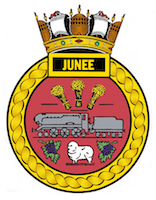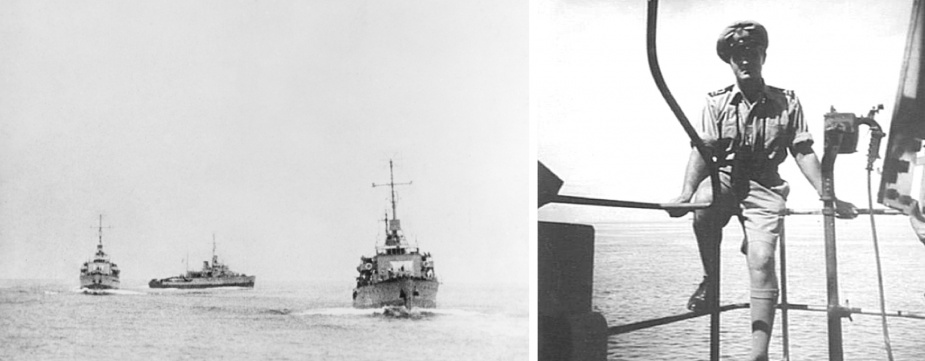HMAS Junee
| Class |
Bathurst Class |
|---|---|
| Type |
Australian Minesweeper |
| Pennant |
J362, M362 |
| Builder |
Poole and Steel Ltd, Sydney |
| Laid Down |
17 February 1943 |
| Launched |
16 November 1943 |
| Launched by |
Mrs Rosevear, wife of the Speaker of the House of Representatives |
| Commissioned |
11 April 1944 |
| Decommissioned |
21 August 1957 |
| Dimensions & Displacement | |
| Displacement | 768 tons |
| Length | 186 feet |
| Beam | 31 feet |
| Draught | 8 feet 6 inches |
| Performance | |
| Speed | 15.5 knots |
| Propulsion | |
| Machinery | Triple expansion, 2 shafts |
| Horsepower | 1800 |
| Armament | |
| Guns |
|
| Awards | |
| Battle Honours | |

HMAS Junee was one of sixty Australian Minesweepers (commonly known as corvettes) built during World War II in Australian shipyards as part of the Commonwealth Government's wartime shipbuilding programme. Twenty were built on Admiralty order but manned and commissioned by the Royal Australian Navy. Thirty six (including Junee) were built for the Royal Australian Navy and four for the Royal Indian Navy.
HMAS Junee was laid down at Poole and Steel Ltd, Sydney, NSW on 27 February 1943. She was launched on 16 November 1943 by Mrs Rosevear, wife of the Speaker of the House of Representatives and was the first RAN warship to carry the name of a medium sized town in the Riverina region of NSW.
Junee commissioned at Sydney on 11 April 1944 under the command of Lieutenant George E Wood RANR(S).
Following successful completion of her trials in the Sydney area, Junee spent a brief period in New Guinea waters before proceeding to Darwin where she arrived on 14 June 1944. Junee remained based on Darwin on anti-submarine patrol and survey duties until February 1945 when she proceeded to Melbourne for a refit after steaming some 28,000 miles. There were no incidents worthy of note during this period of service.
In April 1945 she proceeded to New Guinea waters where she was engaged on convoy escort and patrol duties. It was again mostly routine uneventful service for Junee, but in August she engaged the enemy for the first time when she sank three Japanese barges in Rouang Passage in the Sangi Group, north of the Celebes, while en route from Morotai to Borneo. The cessation of hostilities on 15 August 1945 found Junee at Balikpapan acting as the harbour defence ship.
In September 1945 Junee took part in the evacuation of the remnants of the Australian troops captured by the Japanese in Amboina in 1942. Later in the month she evacuated civilians from Menado (Celebes) to Morotai, and assisted in the transport of the Australian occupation force to Amboina.
In October and November Junee was occupied assisting the restoration of Dutch authority in the Netherlands East Indies. The crew were able to witness colourful ceremonies at Ternate (Halmahera) when the Sultan was reinstated on 8 October and at Kendari (Celebes) on 26/27 November when Dutch authority was officially proclaimed in the area.
On 2 December 1945 Junee's surveillance work in the East Indies came to an end and on that day she sailed from Macassar for Australia. She departed Morotai on 9 December and arrived at Sydney on 23 December 1945. She then proceeded to Melbourne where she paid off on 21 January 1946 after steaming 52,541 miles on war service.
Junee recommissioned as a training ship at Melbourne on 25 February 1953 under the command of Lieutenant Commander Cecil J Cochran RAN. She operated in eastern Australian waters until 12 August 1953, when she sailed from Melbourne for Fremantle. She was subsequently engaged mainly on training duties in western and north western Australian waters until 1957.
In March/April 1957 Junee visited New Guinea calling at Port Moresby, Manus, Madang and Samarai. On 8 June 1957 Junee berthed at Fremantle for the last time as a seagoing ship of the Royal Australian Navy. During her service as a training ship she steamed a further 64,508 miles bringing her total mileage to 117,049 miles.
Junee paid off on 21 August 1957 and on 18 June 1958 she was sold to Mr WG Davies of Fremantle. She was scrapped in 1968 and her hull sunk 20 miles west of Rottnest Island, Western Australia.
Note: This video is hosted on YouTube. Department of Defence users will not be able to view this video on the Defence Protected Network.
This cine film has been placed online as part of the Sea Power Centre - Australia’s ongoing archival digitisation program.
Further reading
- The Corvettes: Forgotten Ships of the Royal Australian Navy by Iris Nesdale - published by the author, October, 1982
- Corvettes - Little Ships for Big Men by Frank B Walker - published by Kingfisher Press, NSW, 1996.
- The Australian Centenary History of Defence Volume III, The Royal Australian Navy edited by David Stevens, Oxford University Press, South Melbourne, Victoria, Australia, 2001.











